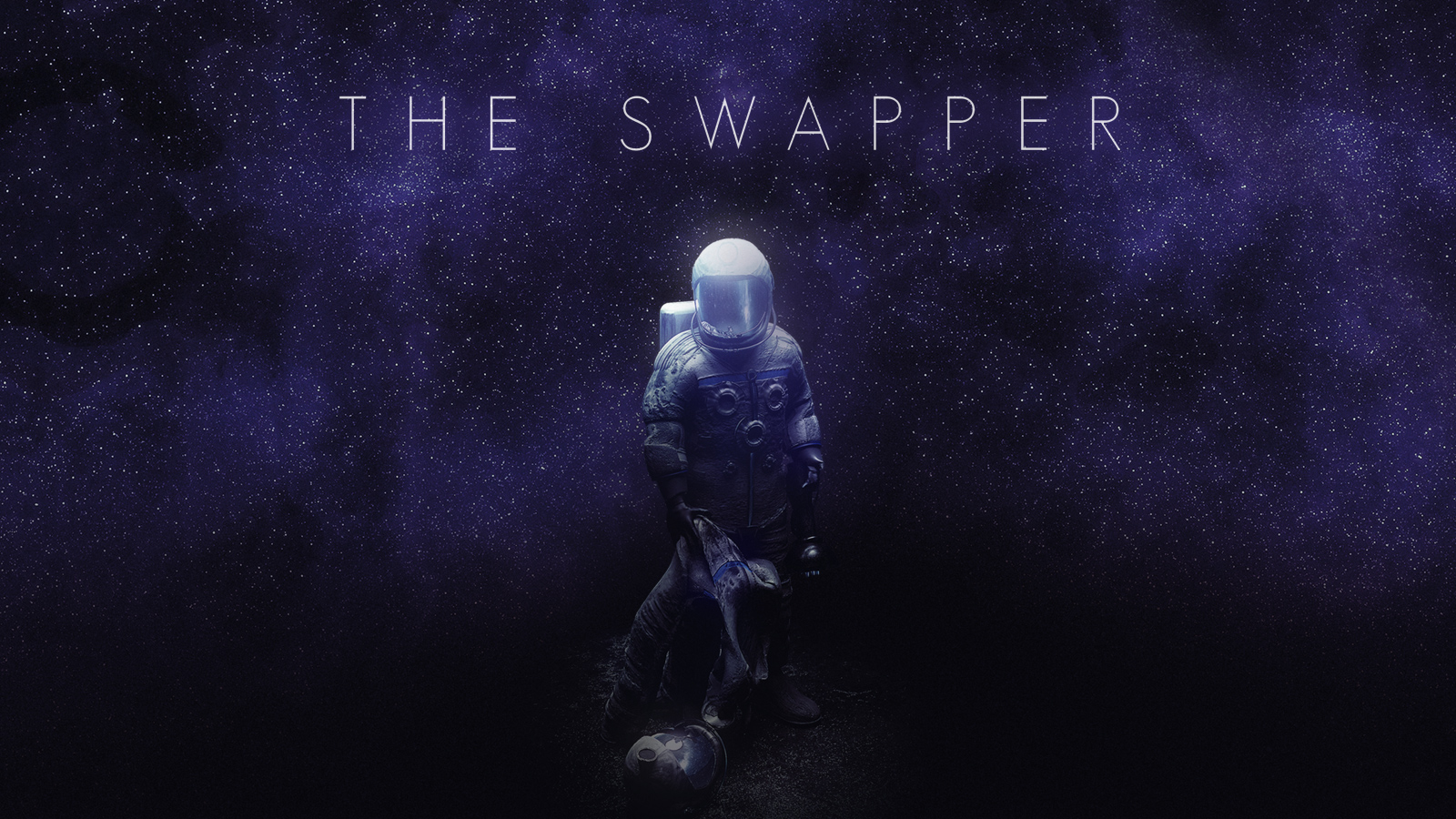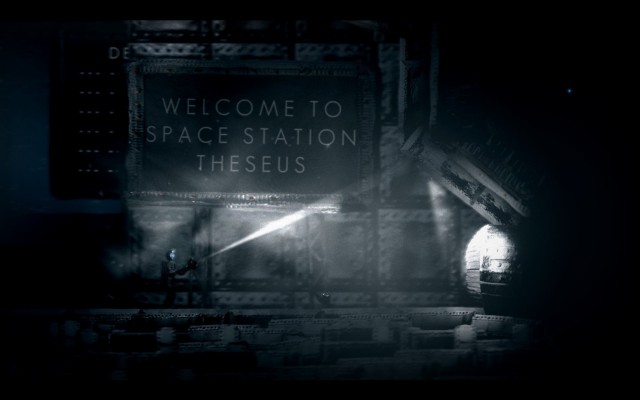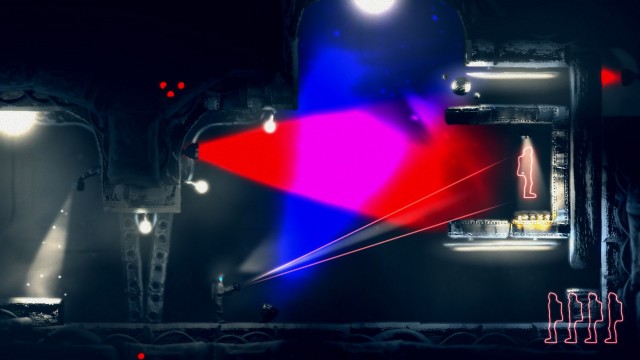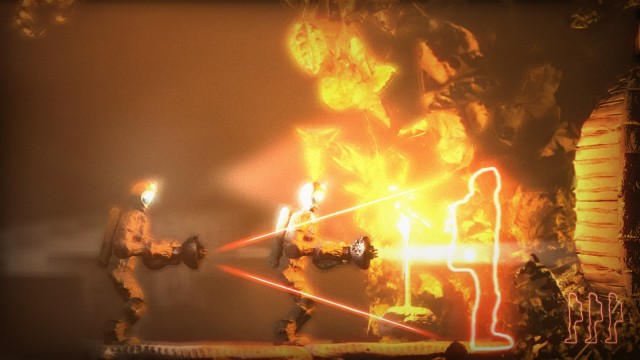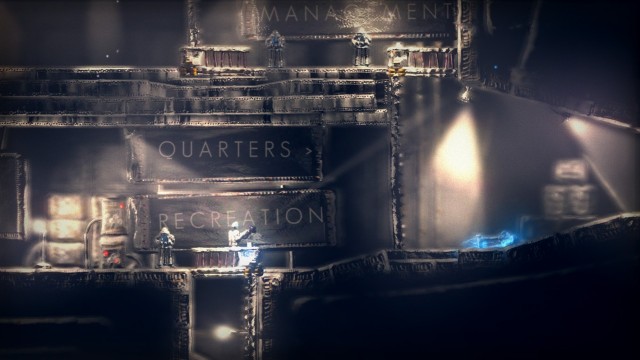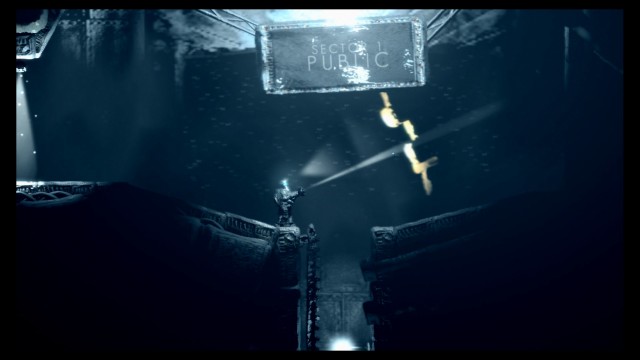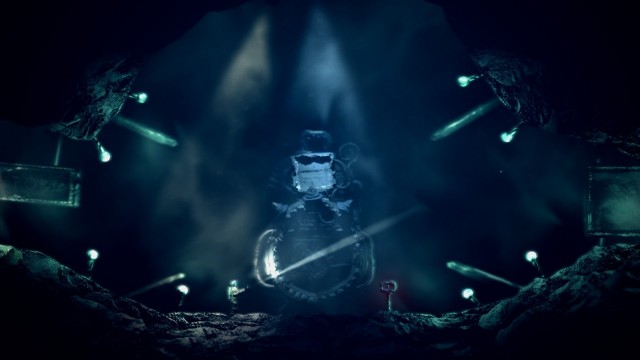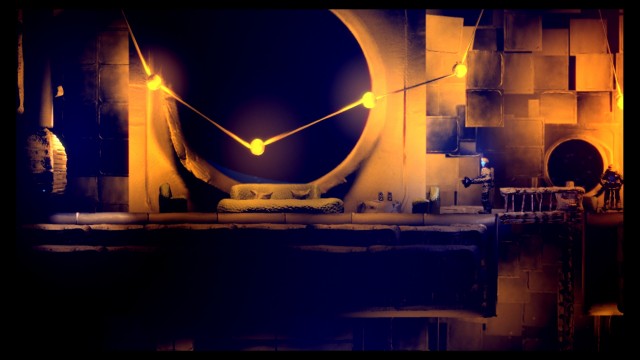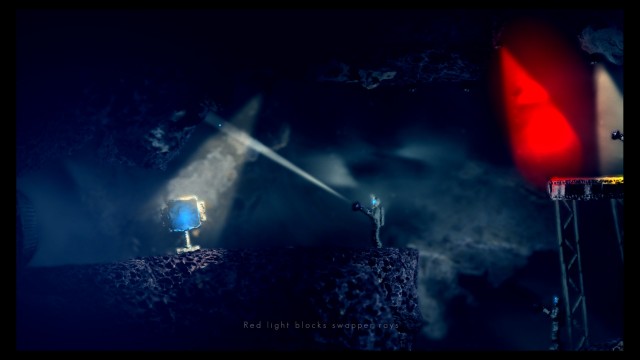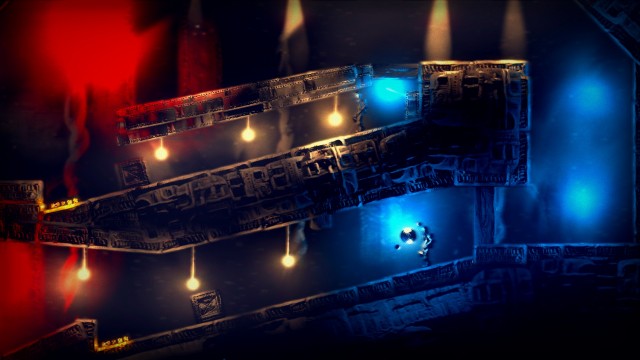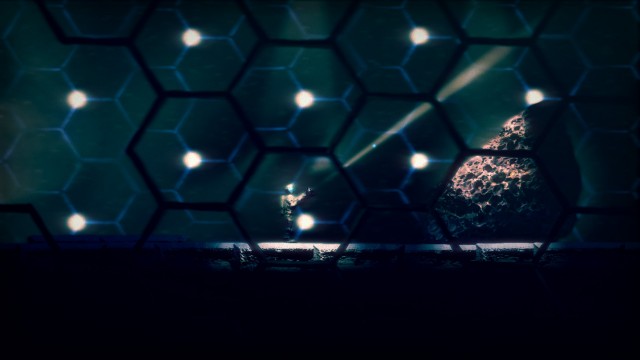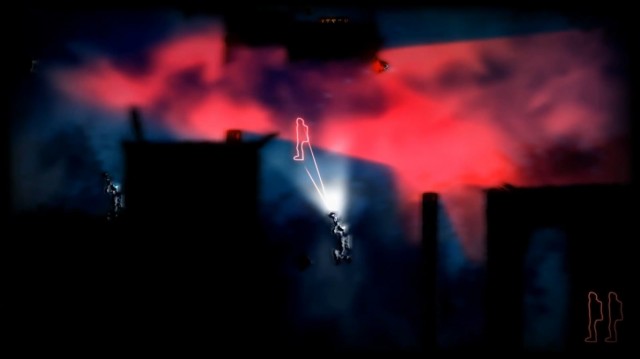UPDATE 2: The Swapper has seen yet another belated release, this time for Xbox One. We have updated the review once again, to include an additional section that comments on impressions of the new Xbox One port.
UPDATE: While our review primarily focuses on the PlayStation re-releases of The Swapper, we have updated it with an additional section to address the belated Wii U version.
Something is very wrong with your surroundings in haunting puzzle-platformer, The Swapper. Mysterious voices pop up on the screen as you walk past leftover samples from faraway planets, a suffocating atmosphere of confusion and death constantly permeates the area, and your sole means of progression is a body-swapping device that may or may not challenge the confines of your character’s very soul.
Like fellow PLAY 2014 game, Rogue Legacy, The Swapper was first released on PC last year. It was put together by a couple of Finnish students at the University of Helsinki, who formed the outfit, Facepalm Games, and was funded by The Indie Fund, a collective batch of indie developers who help to realize other indie games by new game makers. In its original PC build, The Swapper was immensely acclaimed, and even received several indie game circuit awards as well.
Thanks to the efforts of PlayStation Store indie regular, Curve Studios, who previously brought Proteus, Thomas Was Alone and Lone Survivor to PlayStation platforms, The Swapper has now made it to PS3, PS Vita and PS4, as the second PLAY 2014 offering of this Summer. Like the other PLAY 2014 games, it’s also cross-buy and cross-save, so one purchase nets you all three versions together, all of which are freely able to share a save file via the cloud.
Naturally, The Swapper remains an outstanding puzzler on PlayStation platforms as well. Unsettling, beautiful, cerebral and abstract, the game has a very cool and thought-provoking style and story that are entirely its own. It’s also made the gameplay transition to PlayStation platforms exceptionally, being the same awe-inspiring experience on PlayStation as it was on PC.
It may be a little short-lived for the somewhat steep price, but if you have any interest at all in puzzle-based gameplay, The Swapper is an absolute must-play!
The Swapper is absolutely gorgeous compared to the majority of indie games, having all sorts of eerie, surreal detail that makes it a massively immersive experience. In its original PC release, the game looked breathtaking, shining with all sorts of production value, not just for an indie game, but especially for a first-time effort from a couple of university students! On PlayStation devices, The Swapper still looks quite good, but there are noticeable visual discrepancies between the three versions.
As you would no doubt expect, The Swapper is at its visual best on PS4, with that version comparing effortlessly to the superb graphics of the PC version. The PS4 version of The Swapper has the same incredible atmosphere and attention to detail, rendering the starry reaches of space and the dead air of the space station with ease, as well as providing the most detail on your character model, and the lighting and shading effects that often play a part in the game’s puzzles. If you’re looking to emulate the original PC build as much as possible, PS4 is definitely the platform to go with here.
There isn’t too much of a visual downgrade in the PS3 version, but still enough of one to stick out to anyone who owns both consoles, or has already played The Swapper on PC. The PS3 version predictably caps at 720p resolution, unlike the PS4 version, which easily renders at native 1080p resolution. The result is the game still looking cool and atmospheric on Sony’s last-gen console, but also appearing noticeably fuzzier than its PS4 sibling in terms of textures and other such details. Beyond that though, the PS3 version loads and performs at about the same consistency as on PS4.
The PS Vita version is, naturally, the weakest in terms of visuals, but even on Sony’s handheld, The Swapper’s graphics are pretty engrossing. Environments feel pretty ill-rendered compared to the console and PC builds though, and everything feels, well, tiny. The framerate also feels noticeably reduced at times on PS Vita as well, with the handheld appearing to struggle with realizing an indie game that, clearly, is meant to be large in production value, and thus enjoyed on a TV screen or monitor. It’s still certainly not an ugly game on PS Vita, but if you opt for portability, you’ll trade off some pretty noticeable visual compromises as a result.
Even so, you don’t often see independent games with quite this much visual polish, on PlayStation platforms, PC or otherwise.
Virtually the entirety of The Swapper is devoid of background music. Instead, players are left to take in the cold, unsettling emptiness of an aimless space station, floating in the void of the cosmos. This is the kind of indie game that absolutely begs for a great sound system on consoles and PC, and if you’re opting to play on PS Vita, you’ll definitely want to plug in a pair of headphones for the full effect.
Sound effects are also very understated, with most of the game feeling very quiet in general. There’s some slight sounds, such as footsteps, air blasts and the phasing of your Swapper device, but hearing them sound amidst the seemingly endless silence only serves to create an even greater sense of solitude in The Swapper. It’s ironic in a way, since one of the game’s key mechanics involves cloning yourself!
Voice acting is pretty limited, though a handful of British voices will talk on computer screens and such every so often. The voice acting is quite good, particularly with the game wanting players to question their character’s sanity and everything that’s going on in a desolate, lifeless location. As expected, you won’t hear too much of it, but when you do, it achieves the perfect effect.
The Swapper is as much an audio powerhouse as it is a visual one, again packing in the same incredible polish and production value in the sound as it does the graphics.
The Swapper is one of those games that drops you into a foreign, unsettling location, and tasks you with figuring everything else out yourself. You play as a mysterious spacefarer, who has reached the derelict space station, Theseus, for unknown reasons. Are you a survivor of some terrible incident? Are you a rescue worker investigating what happened? Are you a scavenger simply looking to pilfer some ruins? The game doesn’t really tell you, and even the player character themselves is often up to the player’s interpretation.
Regardless, the game is completely devoid of combat. After all, nothing else is alive on Theseus. The entire game revolves around exploring, solving puzzles, and simply trying to figure out what’s going on.
To start, you simply have to wander around and figure things out. You move with either the Directional Buttons or the Left Analog Stick, jump with the X Button, and that’s about it to start. Pressing the Circle Button pulls out a map that you gradually fill out, and pressing the Triangle Button calls up any (vague) information logs that you may stumble across and activate on Memory Terminals with the Square Button, which serves as your context-sensitive action button. It’s pretty simple.
Of course, the game properly begins when you get ahold of the titular Swapper, a peculiar device that allows you to create up to four clones of yourself, and soon after swap your consciousness between them. The original PC controls are translated very well to the various PlayStation button schemes with this mechanic too. Even if you’re limited to shifting your aim with the Right Analog Stick for the most part (though the PS Vita version does allow you to use the Touch Screen to shift your view around), it still feels snappy and intuitive, just like when aiming with the mouse in the original PC build.
Beyond that, the shoulder buttons are effectively used to manage your Swapper functions. You can aim your cursor with the Right Analog Stick to create a clone with L1 or L2 (or L on PS Vita), so long as you have enough space and don’t have four clones already active, and while aiming in the same fashion, you can shift control between the clones with R1 or R2 (or R on PS Vita). This is a simple, but very clever mechanic, and how it’s used throughout the game often leads to the most ingenious, satisfying and flat-out cool environmental puzzles since Valve’s Portal games.
Sure, many of the puzzles still incorporate simple blocks and weight switches, but past the easier early moments of The Swapper, the puzzles start demanding precise accuracy and quick thinking, which is why it’s a good thing that all three PlayStation builds allow you to adjust the sensitivity of the stick movement to your liking. In the latter portion of your mysterious quest, the game’s challenges become real mindbenders that are bound to frequently stump most players, incorporating altered gravity, Swapper-blocking lights, and even the need to methodically kill your clones when necessary, something that may have players feeling a tinge uncomfortable, for all the best reasons.
Solving puzzles is required to get your hands on Orbs, which are the game’s necessary key collectible. You must attain a certain amount of Orbs to activate consoles that alter Theseus’ layout and open new paths, allowing you to proceed with the game. You can temporarily skip certain puzzles and open new paths so long as you have enough Orbs, though you can’t complete the game until every last puzzle on Theseus is solved.
In this respect, The Swapper is both pleasantly simple and deceptively complex. As players proceed deeper and deeper into Theseus, they’ll be met with more questions, and will only experience more confusion. Even after you do successfully complete the game, you won’t necessarily get answers for everything. Again, the entire allure of The Swapper is in its mystery, derived in turn from its foreboding environment.
In fact, given such an incredibly thought-provoking and hauntingly memorable experience as The Swapper, it’s kind of a shame that the game is rather short, especially for the hefty price of $19.99 on the PlayStation Store. It should provide a reasonable amount of play time if you don’t look up solutions online, but if you’ve already played the PC version, and know exactly where to go and what to do, you can easily blast through The Swapper in just over a couple of hours. It’s a wonderfully engrossing game while it lasts, but once you finish it, there’s very little reason to play it again, beyond simply wanting to re-live the experience.
The one saving grace in terms of replay value, which will indeed add far more play time for people not looking things up online, are ten hidden consoles that help to shed a bit more light on the story. Finding these ten consoles is the only way to earn The Swapper’s ten trophies, just as with the PC version’s Steam achievements, and that means that it’s easily possible to play through the entire game without earning a single trophy. These secret terminals are incredibly well-hidden, and they are among the most devious hidden collectibles in gaming, so wanting to track them all down without looking up their locations is a decent way for trophy hunters to get their money’s worth, so long as they haven’t entered the final door and wrapped up the game.
Thankfully, Theseus features an array of teleporters, which allow you to move between major areas of the station with ease. This allows you to effortlessly go back to puzzles you may have missed, as well as look for those secret terminals that the trophies are contingent on.
The Swapper is one of those abstract and surreal puzzlers that you sort of have to play to understand, but as far as puzzle-platformers go, it’s certainly among the best, indie or otherwise!
Again, The Swapper’s story and lore are all incredibly vague. Some players may be frustrated about how annoyingly little answers the game provides, particularly with its almost nihilistic philosophy on life, death and the human soul.
On the other hand however, The Swapper’s mysteries become all the more cool and engaging when they’re so effectively left up to a player’s imagination. It’s sort of refreshing that the game doesn’t spoonfeed you every element of the story, trusting players to piece together what’s going on by themselves, in a mature and rewarding fashion that lets the game’s audience draw their own conclusions.
What can be gleaned from the story is as follows; Earth has exhausted its natural resources, and has built an array of space stations to try and mine for materials on other planets. Two of these space stations end up compromised however, and another, Theseus, goes completely quiet. A mysterious stranger thus finds themselves wandering about the space station, which is entirely devoid of life. Why are they there? What’s going on? What is the player character’s purpose? All unknown. As players are tormented by mysterious messages and increasingly unsettling memory terminals, they must piece together the mystery themselves, and what part they may have to play in it, all the while mastering an ominous technology that allows them to clone themselves and swap minds with their creations.
Obviously, a lot of existential and heavily philosophical questions are raised in the long term while playing The Swapper, giving it a very ambiguous and cerebral tone. In every respect, it’s a game for players that really want to think, but it will reward those players quite handsomely all the same.
The Swapper’s belated release on Wii U is remarkably polished and well-realized. The Wii U port matches the PC original beat-for-beat in terms of graphics and performance, and noticeably outclasses the PS3 version on both counts as well. While it falls a bit shy of the PS4 version in terms of its technical chops, The Swapper is still a beautiful and haunting masterpiece in its Wii U incarnation.
The game does come with some Wii U-specific features in this case, namely off-TV play on the Wii U Gamepad Screen, and the ability to use the Wii U Gamepad as a convenient, swipe-capable map otherwise. While you do unfortunately lose achievements/trophies on Wii U, that simply means that there’s no reward for seeking out the ten hidden terminals throughout the game world, beyond the information on them. Other than that, the experience and content is completely identical on Wii U as it is on PlayStation and PC.
One potential gripe that some may have with the Wii U version of The Swapper is that they’re pretty much limited to playing with the Wii U Gamepad. There’s no Wii Remote or Wii U Pro Controller support, which will be disappointing to people who prefer these control methods. On the bright side, the Wii U Gamepad controls are perfectly comfortable and intuitive, and suit the game perfectly well.
There’s no reason to double down on The Swapper for Wii U if you’ve already played through the game on PlayStation or PC, especially given that the game is still priced at a mean $19.99 on the Wii U eShop, despite its short length. If you have yet to experience this indie gem however, and like the idea of playing it on your Wii U, Curve Studios has delivered a high-quality Wii U port for the game that is definitely worth the attention of Nintendo gamers!
The Swapper is especially late to the party on Xbox One, where it’s released a full two years after the original PC version, and just under a year after the game made its console debut on PlayStation platforms. Fortunately, it was worth the wait for the Xbox faithful, as The Swapper remains an amazingly atmospheric and wonderfully pensive puzzle-adventure game on Microsoft’s console!
The Swapper’s Xbox One build is pretty well identical to that of the PS4 version, in terms of graphical fidelity and performance, giving it a slight, but barely noticeable visual edge over the Wii U version in turn. The Xbox One version also starts at $14.99, slightly cheaper than the $19.99 asking price that the game commanded on PlayStation platforms and Wii U. You do lose some of the advantages in other versions, namely the cross-buy benefit of the PlayStation versions and the Gamepad functionality on Wii U, but even if it feels like the most perfunctory of the console releases, The Swapper has no issues at all on Xbox One.
With that said however, the game also doesn’t add any new content on Xbox One, with its achievements still simply consisting of finding the ten hidden terminals, and nothing else. If you’re looking up their locations, The Swapper delivers an incredibly easy 1,000 Gamerpoints for achievement hunters, but that’s really the only thing separating it from the other versions of the game. If you’ve already played The Swapper on PC, PlayStation platforms or Wii U, there’s absolutely no reason to double-dip on the Xbox One version. If you have yet to experience The Swapper due to being an avid Xbox gamer that originally missed out on the game however, it’s still a masterpiece, and still an absolute must-play in its expansion to Microsoft’s console!
The Swapper is truly stellar, and it’s just as stellar on PlayStation platforms as it was on PC last year. The game is a smart and wonderfully atmospheric puzzler that will tax players’ brains in all the right ways, and it’s absolutely brimming with incredible production values, particularly for an indie game by a small, first-time developer. Top all that with a very rich setting and a very interpretive overarching plot, and you have one of the most thoroughly excellent indie offerings to come along in quite some time, even when stacked against the comparably superb preceding PLAY 2014 game, Rogue Legacy.
Truth be told, The Swapper still feels best optimized and designed for PC, with the PC version having surprisingly lenient system requirements, considering the production values on this game, and also readily supporting Mac and Linux to boot. The fact that the PC version is also $5 cheaper, at merely $14.99 on Steam, makes it provide a slightly better value in contrast to the PlayStation versions.
Of course, the PlayStation versions are still fantastic if you opt to go that route, and even if you pay a bit of an excessive premium on the PlayStation Store, with The Swapper commanding an increased $19.99 price on Sony’s devices, you at least get cross-buy and cross-save capability between all three of Sony’s current platforms. This may not be a perfect incentive though, given the game’s potential brevity, and considering the fact that the experience only feels truly fully comparable to the PC version on PS4.
If you do enjoy games that stretch your thinking though, The Swapper absolutely can’t be missed. If the high price on the PlayStation Store deters you a bit, perhaps you should wait for the game to go on sale, which the PC version may do just as easily on Steam. Still, at some point, be sure to play the game. It’s one of the most satisfying mindbenders that you’ll ever experience!

